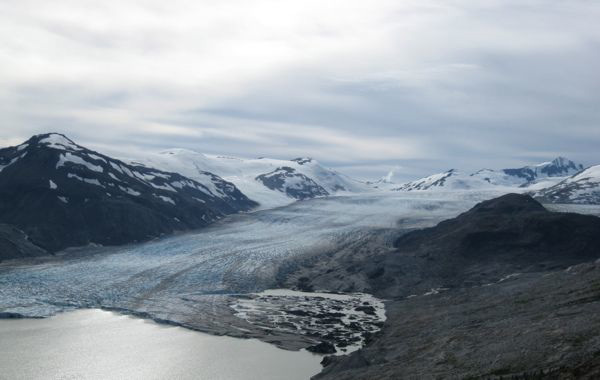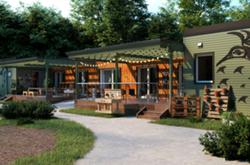
It's only been two years since Dan Moore last visited Bridge Glacier, but things have changed.
As our float plane makes a pass over Bridge Lake -- a pool of meltwater that has formed just below the glacier -- Moore points out the window at a dock where he had hoped to unload our gear. It's half-submerged, and nowhere near the rocky shore. It didn't last long before it was taken out, likely by one of the many whale-sized chunks of floating ice that crowd this expanding body of water.
That's another thing that's changed. Satellite photos show the icebergs multiplying from year to year as the glacier shrinks and the lake becomes larger. Bridge Glacier is losing 200 metres of ice per year on average, making it one of the fastest-shrinking glaciers in the province.
Our pilot finds a clear section to land and gets us as close to the edge as possible. Lucy, one of Moore's students, makes a leap from the plane's right float and scrambles up the steep edge, anchoring us in place with a rope while we unload gear as quickly as possible.
As soon as we're done the plane is off again, and it's just us and the glacier; a large impressive, icy monolith looming in the distance. It suddenly feels very lonely up here, 1,394 metres above sea level in the Coast Mountains north of Pemberton.
Moore, on the other hand, is visibly excited to be here. The UBC geography professor specializes in hydrology -- the movement, distribution and quality of water -- but one of his major research interests is how melting glaciers will impact streamflows in the regions they inhabit. Which is good, because Moore happens to love glaciers.
Being near them, he says, "feels like being out in the real mountains."
Since 2005, he and members of his research team have been monitoring Bridge Glacier as part of their work with the Canada Cryospheric Network, a consortium of university, private and government scientists who are studying links between glacier change and climate change.
Scientists like Moore know that glaciers are melting as the climate warms; that much is clear. They also know that climate change will change the movement and distribution of water in glacial-fed areas, which is most of British Columbia. Because of this, glaciers play a significant role in keeping the province's hydroelectric system running.
The Bridge Glacier, in particular, is like a very big battery for an important hydro system.
From the mouth of the glacier, the Bridge River flows southeast through the Coast Mountains for about 100 kilometres, before hitting the first of three dams that make up the Bridge River hydroelectric complex. These dams, which control the water inflow to four generating stations, produce 492 megawatts per year (or six to eight per cent of the province's electrical supply), making the Bridge complex the third-largest power generator in the province.
It's not clear exactly how Bridge Glacier's retreat will impact the amount of electricity that can be generated downstream. But according to some scientists, it's becoming more apparent that we should start planning for less.
'Time release mechanisms'
Why are glaciers important to stream flow, and hydro, in the first place? Matthew Beedle, a PhD candidate at the University of Northern B.C. studying glaciers in relation to climate variability, describes glaciers as "nature's beautiful time release mechanisms."
During the long hot days of late summer and early fall -- just when precipitation drops off and after all the snow is already gone -- is when glaciers start to melt. The gush of icy water replenishes the glacial watershed.
"This is a critical time for salmon coming upstream, and it can also be a critical time for power demand," says Beedle. "And glaciers are there to contribute to streamflow."
In a stable climate, glaciers "recharge" each winter when they accumulate more snow and ice. "But unfortunately, in a warming climate, you don't get that recharge," says Beedle. "So we're just drawing from that reservoir."
Beedle, who is also a Pacific Institute for Climate fellow, created the website GlacierChange.org to try and make the issue of melting glaciers, and the implications thereof, accessible to a more mainstream audience.
There are about 15,000 glaciers in British Columbia. In 1985, they covered 28,800 square kilometers. By 2005, they covered 25,000, a loss of 3,000 square kilometers, or about 11 per cent.
It stands to reason that a more rapidly melting glacier would mean more water -- more streamflow -- coming down the mountains. For a while, that was the case.
In 2006, Moore and a colleague looked at the August stream flow from 236 hydrometric stations in B.C. that captured water from a range of glacialized regions, including the Coast-Bridge system where the Bridge Glacier is located. They were surprising to find that August stream flow was lower than in previous decades -- even though the glaciers were still losing mass.

Beedle explains that, as glaciers melt, they also lose surface area that is exposed to the sun. The melting slows, and at a certain point, the initial surge of water slows down. Moore's study is part of a body of research that all suggest the same thing, says Beedle: most watersheds in B.C. are already past this point. Though they continue to melt, the resulting runoff is less of a "surge" and more like a slow trickle.
Beedle says he and other scientists are just beginning to try and understand how this will impact hydroelectric generation. Modelling in this area is relatively new, says Beedle, and because no two watersheds are alike, models can't predict what's going to happen across the board anyway.
'Long term outlook not good'
So how is BC Hydro responding the issue?
In a 2009 BC Hydro blog post, author Rob Klovance writes that "the long-term outlook is not good" for the province's glaciers.
He quotes Sean Fleming, a hydrologic modeller working on BC Hydro's Runoff Forecasting Team, who says that water lost from shrinking glaciers could either be compensated or aggravated by other climactic changes -- like snow melt, temperature and precipitation.
"The question is how will these balance out to create a net impact on hydro power availability," stated Fleming.
BC Hydro's media relations department refused this reporter's repeated requests to interview a member of the Runoff Forecast Team about Bridge Glacier specifically. Neither senior media relations advisor Greg Alexis nor director Chris Brumwell would explain why.
Instead, they offered the following via email, to be attributed to Stephanie Smith, BC Hydro's manager of hydrology and technical services.
"BC Hydro is just beginning to understand the projected impacts to stream flows in the Columbia basin under climate change, where decreases in glacier melt are expected to be somewhat compensated by a projected increase in annual precipitation."
The email also states that "BC Hydro has commissioned research into glacier impacts primarily in the Columbia River basin... more research remains to be completed to assess the impacts on water supply to more heavily glaciated watersheds in the Cheakamus and Bridge River basins. Similarly, further analysis of impacts on electric generation also remains to be completed and we anticipate this will be starting in 2012."
Meanwhile, decreased glacial ice and mountain snowpack is already having a "critical" impact on hydropower in countries like Bolivia, Peru, Columbia and Ecuador, according to the U.N.'s Intergovernmental Panel on Climate Change.
A 2009 study by Lausanne's EPFL technical university forecasted a decline in Swiss hydro generation from 46 to 60 per cent by the year 2035 as precipitation declines and total energy use increases. And that's based on a forecast runoff decrease of just seven per cent by the year 2049, and includes forecasted precipitation changes.
How we manage our water resources as glaciers dwindle over the next 50 to 100 years is key, says Beedle.
"You've got a lot of ice up there that in all likelihood is going to come down, as water, within the next century. And that's a lot of potential energy," says Beedle.
"But it's kind of a one-way road."
[Tags: Energy.] ![]()
Read more: Energy
















Tyee Commenting Guidelines
Comments that violate guidelines risk being deleted, and violations may result in a temporary or permanent user ban. Maintain the spirit of good conversation to stay in the discussion.
*Please note The Tyee is not a forum for spreading misinformation about COVID-19, denying its existence or minimizing its risk to public health.
Do:
Do not: